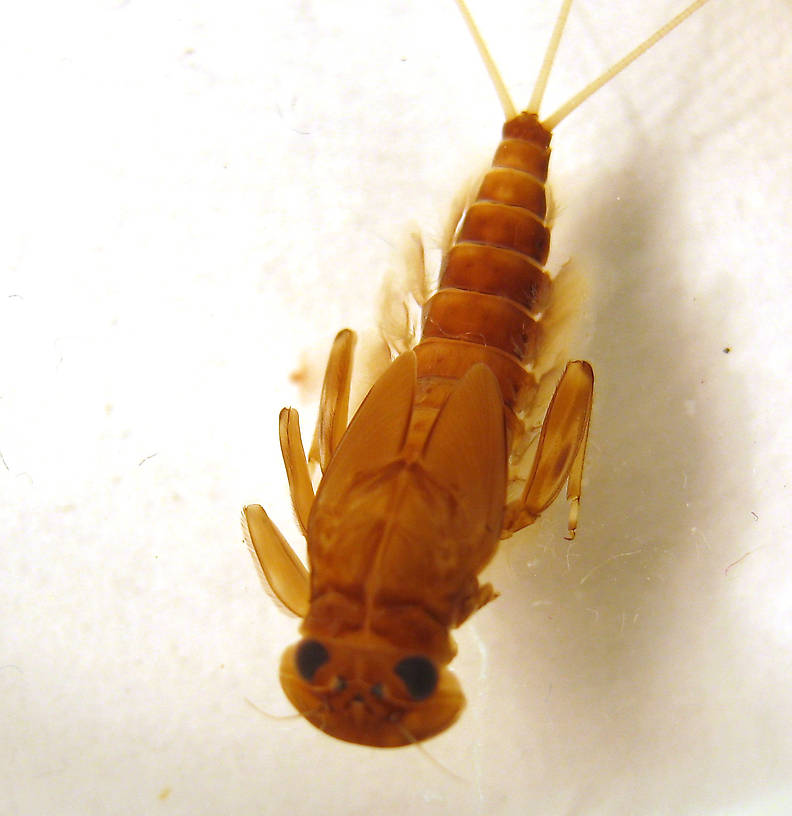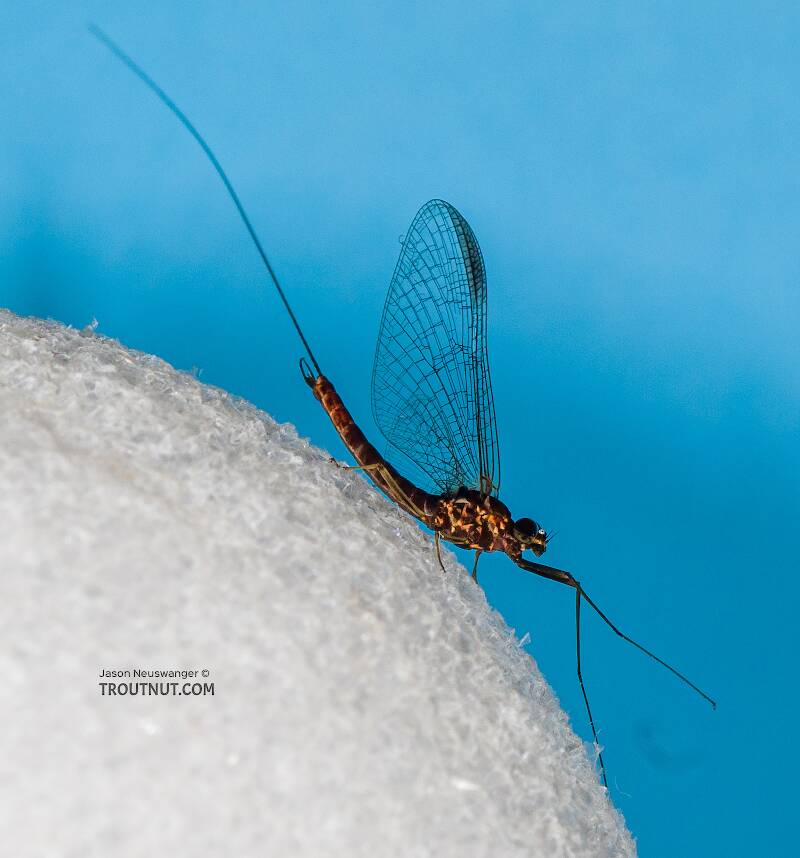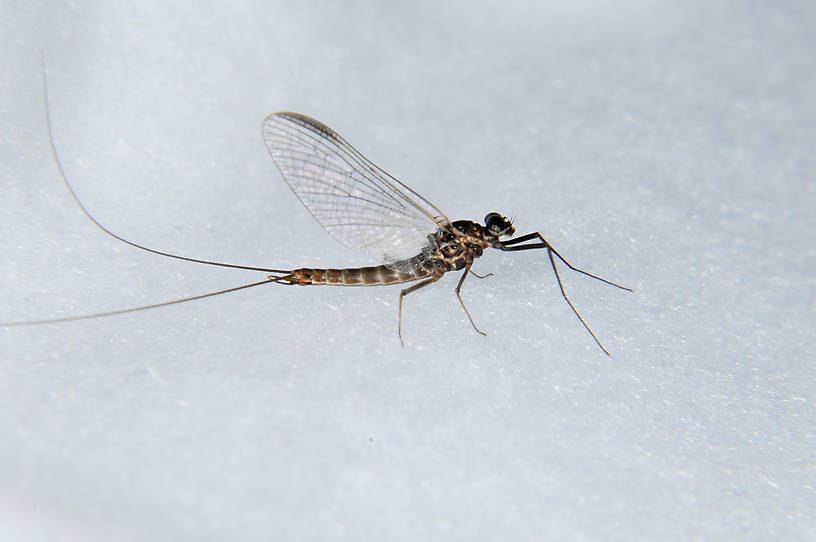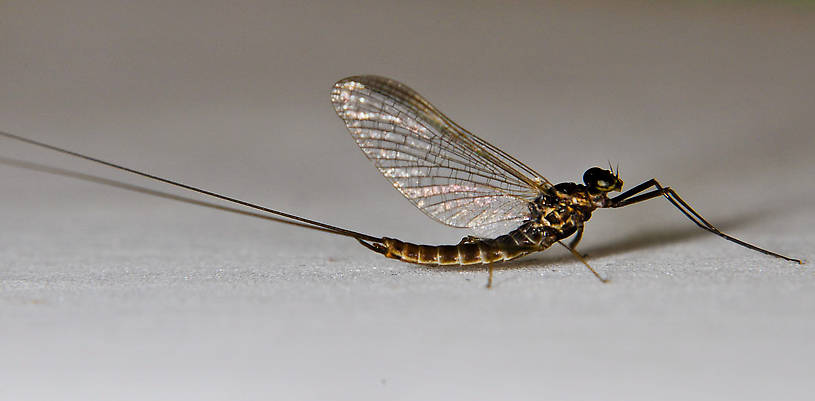
Hex Mayflies
Hexagenia limbata
The famous nocturnal Hex hatch of the Midwest (and a few other lucky locations) stirs to the surface mythically large brown trout that only touch streamers for the rest of the year.


Mayfly Species Rhithrogena morrisoni (Western March Browns)
These large flies range between 9mm and 12mm and are the first important hatch of the year. Generally speaking, they have two distinct color phases and hatching periods, with the Coastal states having the lighter version emerging late February through April in lower elevation tailwaters and the darker version in the Rocky mountain states emerging a month or two later. This has led to much confusion as these significant regional differences are seldom pointed out in angling literature.
They offer the western angler some of the finest fishing of the year during moderate precipitation cycles. It's biggest spoiler is high water or early runoff. On many rivers, there is also a fine hatch of a large late Winter stonefly (Skwala spc.) that usually precedes it that helps to get the fish "looking up". It is the West's equivalent of the East's mottle winged Macaffertium vicarium (American March Brown), both in terms of appearance and importance. Primarily due to western fishing seasons of the past that excluded this mayfly's activity, reporting on this species in angling literature is a relatively recent phenomenon. Thus, it lags in tradition compared to the blotchy winged Heptageniidae of the East and Midwest. But given time...
Where & when
Time of year : Late February to mid-June
Preferred waters: All types of fast water but best in cobble runs of medium depth fast to moderate flow
In 13 records from GBIF, adults of this species have been collected during May (31%), July (23%), June (23%), April (15%), and March (8%).
Species Range
Hatching behavior
The duns leave their nymphal shucks on the bottom making them the ideal candidate to immitate with subsurface emergers either dead drift or on a controlled swing. With the right conditions, they ride the surface for a long time to dry their wings, often making dun imitations ideal. Regardless, fine dry fly action can usually be found along the margins or in back eddies where large trout often like to leisurely sip their supper.Spinner behavior
Time of day: Same as emergence
Nymph biology
Current speed: All current speeds
Substrate: Gravel
Physical description
Most physical descriptions on Troutnut are direct or slightly edited quotes from the original scientific sources describing or updating the species, although there may be errors in copying them to this website. Such descriptions aren't always definitive, because species often turn out to be more variable than the original describers observed. In some cases, only a single specimen was described! However, they are useful starting points.
Male Spinner
Wing length: 10.5-11 mm
A species of the Rhithrogena brunnea (now a synonym of Rhithrogena hageni) group; humeral cross vein blackish; penes outcurved at tip.
Head and thorax dark brown. Pleura largely dark, but with several yellow spots. Fore legs brown; tips of tibiae darker. Middle and hind legs paler, femora with dark brown streaks. Wings hyaline; venation fine, brown. Humeral cross vein deep blackish. Stigmatic area tinted with smoky; cross veins mostly anastomosed or forking. Abdominal tergites dull brown, apical ones darker; posterior margins darker, lateral margins pale yellowish. Sternites dull yellowish, immaculate. Forceps dark brown. Tails dull yellowish to brownish, joinings not noticeably darker. Penes strongly divergent apically, narrowed toward the tip; a small but distinct ventral spine on each lobe, and 5 to 6 small spines ventrally near apex (see fig. 100, after McDunnough). Basal joint of forceps slightly swollen on inner margin.
Allied to Rhithrogena brunnea (now a synonym of Rhithrogena hageni), but with weaker mid-ventral spine on the penes, and stronger apical spines.
Described as R. petulans
Body length 10 mm, wing length 11 mm
A species closely allied to R. brunnea (now a synonym of Rhithrogena hageni); penes narrowed at apex, a small median ventral spine on each.
Frontal portion of head deep smoky grey; red-brown shading at bases of ocelli; vertex dark red-brown. Greyish streak across face in antennal region; antennae dark red-brown, tips paler. Pronotum dark olive-brown; darker brown shading along posterior margin. Mesonotum light red-brown with an olive tinge; median streak darker than area on each side. Pale spot anterior to scutellum; dark area on each side of this, from which a dark line extends forward above wing roots. Scutellum and all posterior portions of mesonotum, and posterior half of metanotum, blackish brown. Purplish streak anterior to wing roots. Intersegmental areas of pleura paler, yellowish brown. Narrow dark lines above leg bases. Sternum dark red-brown; anterior portion of mesosternum rather paler. Fore legs dark red-brown; middle and hind legs yellowish olive to yellow-brown. Black longitudinal streak, tapered at each end, on basal half of each femur. Coxae olive brown. Black spot at apex of each trochanter; apices of middle and hind femora, and tarsal joinings of these legs, deep brown; tarsi smoky brown. Wings hyaline; stigmatic area distinctly brown-tinged. Venation dark red-brown; longitudinal veins, especially in anterior half of fore wing, somewhat heavier than cross veins. Humeral cross vein deep purple-black. Basal costal cross veins well defined; about 6 before bulla, those in stigmatic area anastomosed as usual. Slight tendency for cross veins in 3rd and 4th spaces below bulla to be somewhat closer together than usual.
Abdominal segments 2-7 semi-hyaline, light purplish brown with reddish tinge; tergites darker than sternites. Intersegmental areas and lateral margins narrowly paler; posterior margins of tergites narrowly darker dorsally. Traces of a narrow pale mid-dorsal line, short submedian dashes near center of each tergite, and lateral faintly defined wedge-shaped areas based on anterior margin. Segments 8-10 opaque, brighter red-brown, with distinct yellowish tinge. Basal portion of forceps base pale; forceps deep brown, penes paler. Penes only slightly outcurved at apex; small apical spines rather well developed; small ventral spine near middle of each lobe; penes narrowed toward apex. (See fig. 100). Tails deep smoky brown; basal joinings darker, others somewhat opaque.
Specimens of the Mayfly Species Rhithrogena morrisoni
3 Male Spinners
1 Nymph

Status at time of photo - preserved, but photographed within days of capture.
W. C. Day, Aquatic Insects of California differentiates morrisoni nymphs by submedian pale dots on tergites 8 & 9, which look to be in evidence. This is one of the "super-hatches" on this river that can be prolific March through April.
Entoman
Start a Discussion of Rhithrogena morrisoni
References
- Arbona, Fred Jr. 1989. Mayflies, the Angler, and the Trout. Nick Lyons Books.
- Caucci, Al and Nastasi, Bob. 2004. Hatches II. The Lyons Press.
- Knopp, Malcolm and Robert Cormier. 1997. Mayflies: An Angler's Study of Trout Water Ephemeroptera . The Lyons Press.
- Needham, James G., Jay R. Traver, and Yin-Chi Hsu. 1935. The Biology of Mayflies. Comstock Publishing Company, Inc.
- Swisher, Doug and Carl Richards. 2000. Selective Trout. The Lyons Press.
Mayfly Species Rhithrogena morrisoni (Western March Browns)
Species Range
Common Names
Resources
- NatureServe
- Integrated Taxonomic Information System
- Global Biodiversity Information Facility
- Described by Banks (1924)




